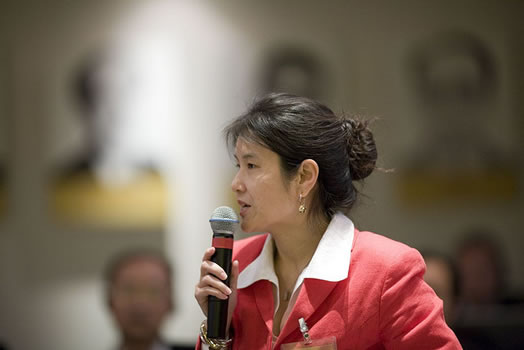
(Photo by JUCCE)
Imagine you’re about to take the stage to give your short talk and you’re not (yet) a household name. Should you have someone else introduce you onstage or should you introduce yourself?
The “safe” way is to have the moderator or a friend introduce you, perhaps using a short biography you’ve written to help guide them. It’s safe because the audience already knows the person introducing you, and therefore presumably trusts them. The person introducing you can also lavish praise on you that would look egotistical if you did it yourself. But this introduction comes with serious costs: you’re not in control of the content, the delivery, nor the tone. And more importantly – it robs you of the opportunity to make your own first impression. Someone else has defined who you are and the content of your speech. In a way, they’ve stolen some of your “thunder” by sharing the limelight with you for these first critical minutes.
The “usual” way to introduce yourself is to recite the litany of your achievements. The idea is once people see your expert credentials, they’ll trust what you say to be backed by experience (and not simply opinion). This is also safe, because it’s what people expect. But this usual way also has major flaw: you’ve robbed yourself of the opportunity to make a dynamic first impression. You’ve taken the first minutes talking about you and not about what the audience is there to hear – something about them.
The Speak With Passion way is to start with a story that frames you. Let’s say you’re an expert on a radical new way to manufacture widgets. People have been building the widgets the same way for decades. It’s tried and true. In fact, it’s the industry standard and seen as a best practice by all the experts in the field. But you discovered something that wasn’t obvious at first glance, and spent the last five years re-inventing the process. You have some modest success, but all the leaders in the field see what you’re doing as either stupid or reckless. They don’t see what you see. So instead of introducing yourself with credentials, tell your audience about your “Aha!” moment five years ago:
“I’m a true believer in best practices, but I know one of ours is flat-out wrong. I need to share my insights with you because otherwise we’re soon all going to be dinosaurs. You see, five years ago I knew, like you know, how to build great widgets. I studied with the best and even won some notoriety. Business was good, but something bugged me about the process. I didn’t want to believe that I saw a mistake – because who am I to contradict the established way? But this is what I discovered…”
This format of self-introduction has some key points:
- You make yourself an “everyman” instead of a “superman”. We’re used to hierarchy – the smarter, more powerful, richer, better looking people are at the top, and generally the rest of us look up to them. Instead of putting yourself on a pedestal, give your audience the opportunity to do so.
- You make the focus your passion and not yourself. By focusing on what you’re interested in, your audience will naturally feel your passion and be excited by it. Remember that the audience doesn’t really care about you – they care about themselves. Take care of that need early on.
- You share your epiphany as a personal story. You could tell people what they need to do differently, but that lecture format can come across as dry and boring. By sharing a story, you give your audience the gift of seeing the world through your eyes. They may reject your “aha”, but they won’t reject you as a person. Your personal story is also more memorable than facts or processes.
Instead of trying to sell people from the stage, share yourself with the audience in a way that they care about. The end result is something that benefits everyone.


 I am starting a safari camp in Zambia and I would like some ideas on how to make my safari experience stand out from the other safari holidays in Zambia and maximise my advertising.
I am starting a safari camp in Zambia and I would like some ideas on how to make my safari experience stand out from the other safari holidays in Zambia and maximise my advertising. We have an improv and are considering doing TV advertising via comcast spotlight. It seems a good way to reach more of our target area. Any thoughts the idea? Cost to produce a spot? Suggested length of spot?
We have an improv and are considering doing TV advertising via comcast spotlight. It seems a good way to reach more of our target area. Any thoughts the idea? Cost to produce a spot? Suggested length of spot?
 I need a campaign strategy to release a new, improved product based on a well established core story. Where do we start? I have about a six month window to create the image. Educate and inform the public and establish the buying criteria for this release of an established product. This is a release of a product that already has acceptance by an audience. The re-formulated version is entirely “GREEN.” The change in the formulation was brought about by market demand. The first launch was a successful one and the original product still has a strong following. The new release needs a specific marketing plan in order to take advantage of the current popularity of the products efficacy along with the new “GREEN” formulation for previous interested users that pushed back because it was not. I’m wondering how to start marketing the new version.
I need a campaign strategy to release a new, improved product based on a well established core story. Where do we start? I have about a six month window to create the image. Educate and inform the public and establish the buying criteria for this release of an established product. This is a release of a product that already has acceptance by an audience. The re-formulated version is entirely “GREEN.” The change in the formulation was brought about by market demand. The first launch was a successful one and the original product still has a strong following. The new release needs a specific marketing plan in order to take advantage of the current popularity of the products efficacy along with the new “GREEN” formulation for previous interested users that pushed back because it was not. I’m wondering how to start marketing the new version.
 I have been tasked to create the agenda for an all hands internal marketing team summit. I am looking for ideas and suggestions on fun topics, interesting videos, a good book to hand out, team building activities, etc… Do you have any experience or examples of successful agendas, it would be greatly appreciated.
I have been tasked to create the agenda for an all hands internal marketing team summit. I am looking for ideas and suggestions on fun topics, interesting videos, a good book to hand out, team building activities, etc… Do you have any experience or examples of successful agendas, it would be greatly appreciated.
 I’m having trouble coming up with ideas for a software analysis video that needs to be created for the launch in a 1.5 weeks. It doesn’t have to be fancy but clear, concise and targeted to an engineering type audience.Length: 3-5 minutes long. I have a PowerPoint that can be used to show certain things. The main aspect to be highlighted is that the software works in 4 steps (1-Collect Data, 2-Store Data, 3-Analyze Data, 4-Report on the Data). Budget is around $3-$5k. I was thinking a voice over with someone talking through imp parts of the PowerPoint. I can have a videographer take video of a Demo. But I need some solid ideas as I’ve never planned a small software video before.
I’m having trouble coming up with ideas for a software analysis video that needs to be created for the launch in a 1.5 weeks. It doesn’t have to be fancy but clear, concise and targeted to an engineering type audience.Length: 3-5 minutes long. I have a PowerPoint that can be used to show certain things. The main aspect to be highlighted is that the software works in 4 steps (1-Collect Data, 2-Store Data, 3-Analyze Data, 4-Report on the Data). Budget is around $3-$5k. I was thinking a voice over with someone talking through imp parts of the PowerPoint. I can have a videographer take video of a Demo. But I need some solid ideas as I’ve never planned a small software video before.